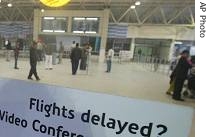2007年VOA标准英语-India's Airports Fail to Keep Pace With Growing(在线收听)
New Delhi
21 January 2007
India's aviation sector is booming, but the infrastructure at the country's airports has not kept pace with the growing traffic. The result: delays, bottlenecks, congestion and sometimes chaos at the country's biggest airports. From New Delhi, Anjana Pasricha has a report.

The arrival lounge at the domestic terminal of the Indira Gandhi International Airport is bereaved of activity in New Delhi
At the start of the year, chaos overtook New Delhi's airport as fog shrouded the city. Hundreds of flights were canceled or delayed, and thousands of passengers flying in or out of the Indian capital were stranded around the country.
Winter may have aggravated the situation, but harried passengers have become accustomed to bottlenecks at airports in major cities such as Delhi, Mumbai and Bangalore.
The reason is simple: India's outdated and rundown airports are woefully inadequate to handle the massive surge in traffic in the past three years.
Kapil Kaul at the Center for Asia Pacific Aviation in New Delhi says rising middle-class incomes and a host of new, low-cost airlines have led to an increase in the number of domestic fliers. A rising economy also is drawing in more foreign business travelers. But the airport infrastructure has not been upgraded to match the boom in traffic.
"We did two things. From [19]'96 to 2004 there has been an underinvestment. Nobody invested in airport capacity," said Kaul. "And secondly from 2004 we opened up our markets, we allowed more airlines to come, both domestic and international."
"That has pushed the traffic, domestic growing at 48 percent, international grew 16 to 20 percent," continued Kaul. "These are huge numbers. Cargo is growing. Clearly, I think our airports do not have the infrastructure to handle this volume of traffic."
Frustrated passengers know that all too well. Airport terminals are bursting at the seams. There are too few runways, planes circle the airport for as long as 45 minutes while waiting for a landing slot. Passengers may not find seats in the terminals while waiting for flights.
The government is addressing the problem. India will spend $8 to $10 billion by 2010 on upgrading existing airports and building new ones in smaller cities.
Two private consortiums have begun modernizing New Delhi and Mumbai's airports. Technology hubs Bangalore and Hyderabad are building new airports. Airports at 35 smaller cities also are being upgraded.
Kaul hopes infrastructure bottlenecks will begin to ease in about two years.
"From now on infrastructure would get better. Clearly by 2009-2010 you should begin seeing the infrastructure being in line with what the industry requires," added Kapil Kaul.
Indeed, the government is promising airports on par with the best in the world by 2010, but many frustrated passengers say they will only believe that when they actually step into them.